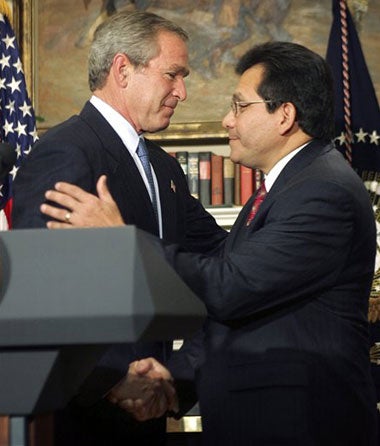Bush eyes second Supreme Court vacancy

No details were given of the condition of Mr Rehnquist, 80, who has spent 33 years as a justice of the court, the last 19 as its head, but his retirement, wrongly predicted many times in recent years, surely cannot be put off much longer.
On 27 June, at the court's final public session of the 2004-05 term, Mr Rehnquist appeared frail. After his cancer was diagnosed last October, he spent several weeks receiving chemotherapy. He re-emerged to administer the oath of office to Mr Bush at his inauguration, but his voice was often faint and rasping, as a result of a tracheotomy to ease his breathing.
Yet when the first Supreme Court resignation in 11 years did finally happen, the person who stepped down was not the Chief Justice, a staunch conservative, but Sandra Day O'Connor, the first woman to sit on the court, and regarded as its crucial swing vote.
That alone presented Mr Bush with the most delicate and far-reaching decision of his presidency. Now the court may have two of its nine seats empty at the same time. The President will thus have an opportunity to leave his mark for a decade or more on an institution at the centre of America's culture wars.
But he also risks igniting a separate war with Senate Democrats, who have indicated they will fight any nominee they find too conservative, especially one whose record suggests he would favour outlawing abortion, on which the court is set to rule again in the new session starting this autumn.
Mr Bush has said he will not announce a nominee to replace Justice O'Connor until lthe end of the month at the earliest. The White House says this is to allow the President to conduct interviews with candidates. But almost certainly, the delay has another reason, to give the President time to factor a possible Rehnquist departure into his calculations. The general expectation is that - despite his professed admiration for Antonin Scalia and Clarence Thomas, the two most conservative members of the court - Mr Bush will choose an outsider to replace Mr Rehnquist.
This would have the huge advantage of requiring only one confirmation hearing. By contrast, to promote one of the seven surviving justices to succeed Mr Rehnquist would mean two hearings, one for the new chief justice, and another for his replacement on the court.
Speculation is rife over potential candidates, most of them from the obvious pool of appeal court justices and eminent college law professors. But pressure is growing on Mr Bush (including, discreetly, from some of the present justices) for a nominee with some political experience.
This could aid the chances of Alberto Gonzales, the Attorney General and an old friend of Mr Bush from his days as a justice on the Texas state supreme court. Several sitting US senators have also been mentioned.
Either way, Mr Bush is guaranteed a torrid summer. Two Supreme Court nominations, and the attendant pitched battles between liberal and conservative camps, would be enough on their own.
But the White Housemust also cope with the continuing row over the presidential adviser Karl Rove, who is accused of being involved in the leak of the name of a CIA secret agent to the media.
It also must decide what to do about John Bolton, Mr Bush's controversial choice for US ambassador to the United Nations, whose confirmation has been blocked by Senate Democrats for three months.
Join our commenting forum
Join thought-provoking conversations, follow other Independent readers and see their replies
Comments
Bookmark popover
Removed from bookmarks